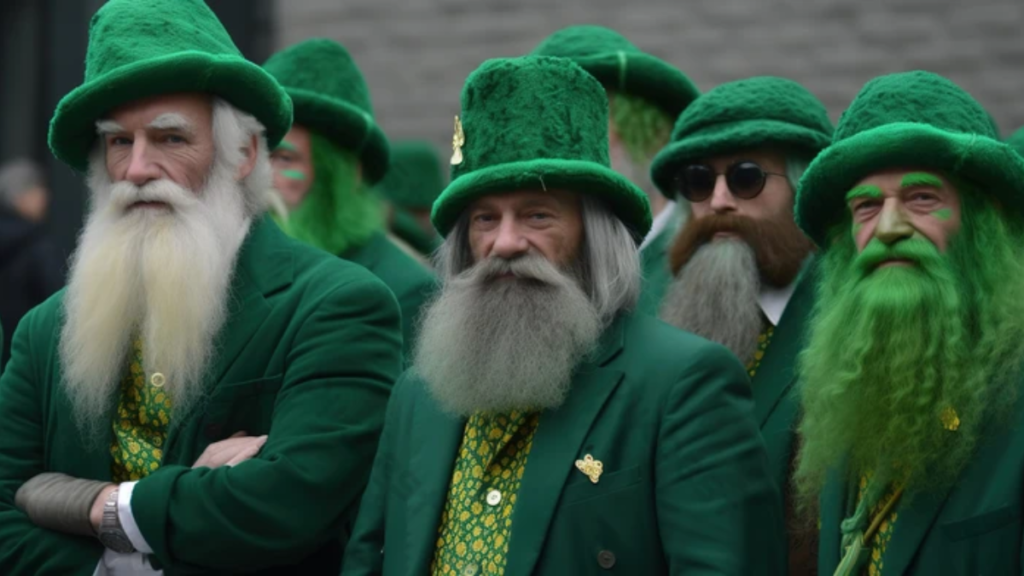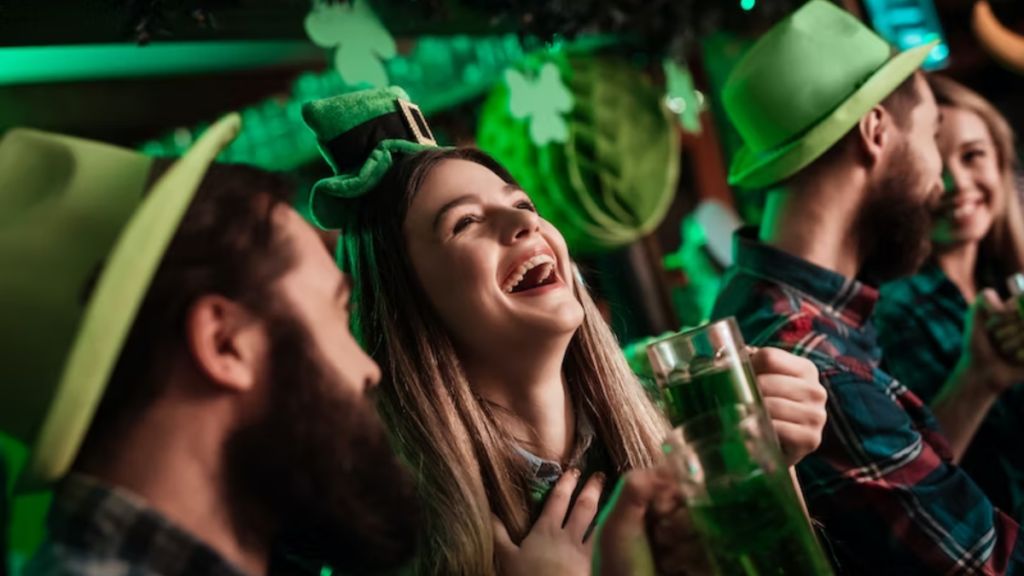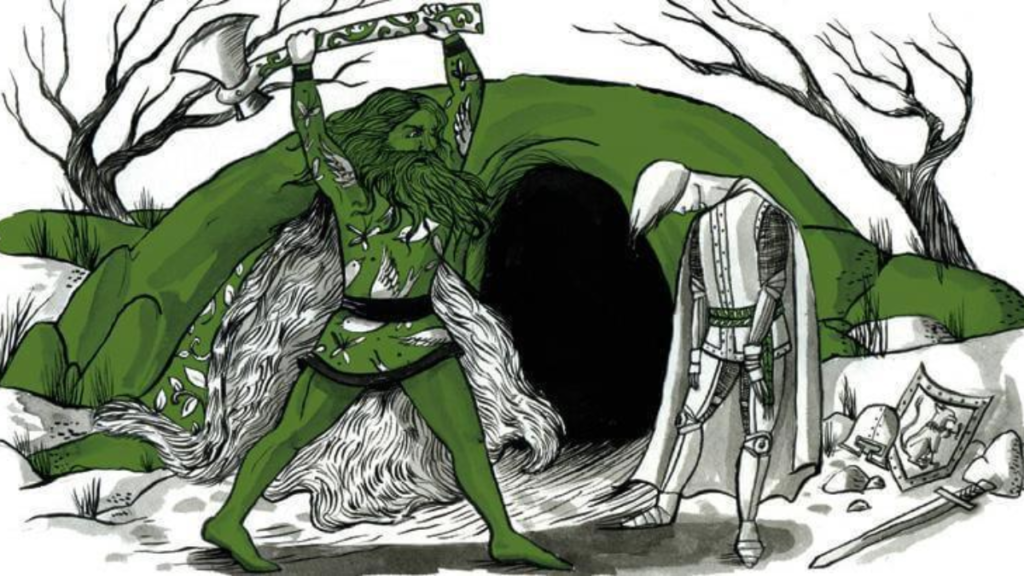Green is a color deeply embedded in Irish culture. It represents the lush landscapes of Ireland, often referred to as the “Emerald Isle” due to its verdant countryside. People also associate the color green with Ireland’s history, folklore, and national identity.
Irish folklore often associates green with magical creatures like leprechauns and fairies, which further deepens its cultural significance. Additionally, the color green ties to Irish politics and history, particularly the Irish independence movement.

How Green Became Associated with St. Patrick’s Day
St. Patrick’s Day, celebrated on March 17th, is a cultural and religious holiday commemorating St. Patrick, the patron saint of Ireland. Over time, the color green has become a significant symbol of this day.
We can trace this association back to the 18th century when the Irish Volunteers, a military organization established in 1778, used green in their uniforms.
The use of green continued into the 19th and 20th centuries, particularly during the Irish Rebellion of 1798 when wearing a green shamrock became a symbol of Irish nationalism.
During the 19th century, when the Catholic Church made the day an official feast day, the color green became further solidified as a symbol of St. Patrick’s Day.
Role of Green in St. Patrick’s Day Parades
St. Patrick’s Day parades are a major part of the holiday’s celebrations. Participants and spectators often wear green clothing and accessories. Green floats, banners, and decorations fill the streets, creating a sea of green that stretches as far as the eye can see.
The first St. Patrick’s Day parade took place in New York City in 1762, and the tradition of incorporating green into these parades has grown ever since.
Evolution of Green as the Color of St. Patrick’s Day
The tradition of wearing green has evolved over the centuries. Today, people see it as a way to show Irish pride and heritage.
Whether it’s a green hat, a shamrock pin, or a full green outfit, wearing green on St. Patrick’s Day has become a widespread tradition around the world.
For example, every year for St. Patrick’s Day in Chicago, they dye the river green, a tradition that has been ongoing since 1962.

Tradition of Wearing Green
Origins of Wearing Green on St. Patrick’s Day
The tradition of wearing green on St. Patrick’s Day has deep roots in Irish history. We can trace it back to the 17th century when people wore green ribbons and shamrocks to celebrate the holiday
However, the practice became more widespread in the 19th century, particularly during the Irish Rebellion of 1798.
During this time, the Irish citizens wore green to express their desire for independence. People saw the color green as a symbol of rebellion against British rule, and it was during this period that people started using the phrase “wearing of the green”.
This phrase refers to the act of wearing a shamrock on one’s clothing as a symbol of Irish identity and support for Irish independence.
Tradition of Pinching Those Not Wearing Green
The tradition of pinching those not wearing green on St. Patrick’s Day is a relatively modern American tradition. The idea behind the pinch is that it makes the person invisible to leprechauns, mythical creatures who would pinch anyone they could see (anyone not wearing green).
People began pinching those who didn’t wear green as a reminder that leprechauns would sneak up and pinch green-abstainers. While this tradition might not be as widely practiced in Ireland, it has become a fun part of St. Patrick’s Day celebrations in the United States and other countries.
Influence of the “Wearing of the Green” on Modern Celebrations
The phrase “wearing of the green” comes from a song of the same name, which laments the repression of supporters of the Irish rebellion.
Whether it’s donning a green outfit or adding a touch of green to your attire, the “wearing of the green” has become an integral part of St. Patrick’s Day celebrations worldwide.
People have expanded this tradition so much that they light up major landmarks around the world, such as the Sydney Opera House in Australia and the Christ the Redeemer statue in Brazil, in green lights to commemorate St. Patrick’s Day.

Green in Irish Folklore and Mythology
Importance of Green in Irish Folklore
People often associate it with the magical landscape of Ireland, filled with leprechauns, fairies, and other mythical creatures.
Generations have passed down these stories and legends, further cementing the significance of the color green in Irish culture.
Mythical Creatures Associated with the Color Green
The most famous of these is the leprechaun, a type of fairy known for their love of mischief and their green attire.
People often depict these mythical beings wearing green coats and hats, which further associates the color green with Irish folklore.
Connection Between Green and Good Luck in Irish Beliefs
This belief is particularly evident in the tradition of wearing green on St. Patrick’s Day.
People say that by wearing green, individuals increase their chances of good luck. This tradition, rooted in Irish folklore, continues in modern-day celebrations.
St. Patrick’s Day Celebrations and the Color Green
The Use of Green in St. Patrick’s Day Decorations and Costumes
Green is the dominant color in St. Patrick’s Day celebrations. From decorations to costumes, the color green is everywhere.
People often put on green clothing and accessories, light up buildings and landmarks around the world in green lights. They even dye food and drinks green as part of the celebrations.
Green-Themed Foods and Drinks for St. Patrick’s Day
St. Patrick’s Day celebrations often feature green-themed foods and drinks. From green beer to green cupcakes, the color green makes its way into the holiday’s cuisine. These green treats add a festive touch to the celebrations and are a fun way to participate in the holiday’s traditions.
The Role of Green in St. Patrick’s Day Parades Around the World
Many cities around the world hold St. Patrick’s Day parades, and the color green plays a significant role in these events.
Participants in the parade often dress in green costumes, and they decorate floats with green banners and balloons.
Related post
- St. Patrick’s Day Pins | Buy Pins Now For This Special Day
- St. Patrick’s Day in Ireland? History, Traditions, Culture
- 30+ Facts About Saint Patrick’s Day And Interesting Information
Conclusion
St. Patrick’s Day has evolved from a religious holiday in Ireland to a global celebration of Irish culture. The tradition of wearing green. Which has its roots in Irish history and folklore, has become a significant part of these celebrations.
Today, people of all backgrounds around the world don green attire. On March 17th to honor Ireland’s patron saint and celebrate Irish heritage.
FAQ’s
Wearing green on St. Patrick’s Day is a tradition that dates back to the 17th century. The color green is associated with Ireland, often referred to as the “Emerald Isle”.
Green is deeply embedded in Irish culture. It represents the lush landscapes of Ireland and is associated with Irish history, folklore, and national identity.
Green plays a significant role in St. Patrick’s Day parades. Participants and spectators often wear green clothing and accessories, and the streets are filled with green floats, banners, and decorations.
The tradition of pinching those not wearing green on St. Patrick’s Day is a relatively modern American tradition.
The shamrock, a three-leafed clover, is a significant symbol in Irish culture.
The association of green with St. Patrick’s Day can be traced back to the 18th century when green was used in the uniforms of the Irish Volunteers.
St. Patrick’s Day is celebrated in many countries around the world with parades, wearing of green attire, public festivals, and the dyeing of rivers or streams green.
As we look to the future, the tradition of wearing green on St. Patrick’s Day shows no signs of fading.

